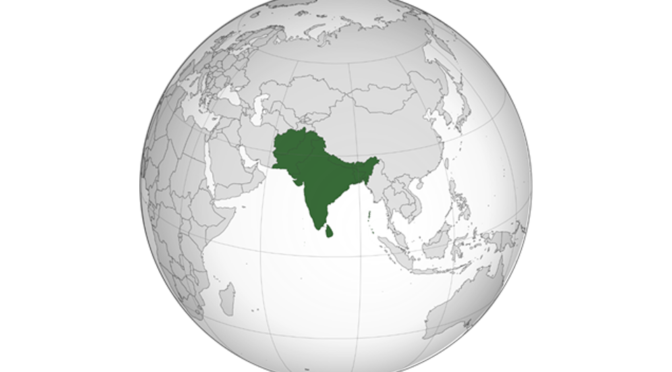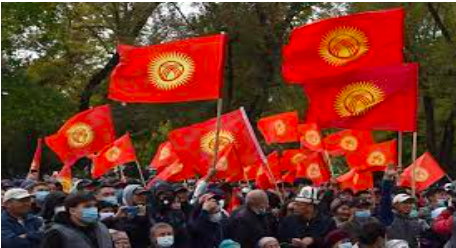On South Asia at the Backdrop of Contemporary World Order
Posted on : July 26, 2021Author : Raunak Bhattacharya

The term, South Asia, is used in Social Science academic parlance to refer to the countries of India, Pakistan, Bangladesh, Nepal, Bhutan, Sri Lanka and the Maldives. This term was popularized and used mostly in the American diplomatic circles, and now the term is so popular that one can find its mention in books for elementary education, as well as entire Departments or Schools at Universities dedicated to the study of the region. The very concept of ‘South Asia’ is indeed modern, as it can be noted. The Western epistemology surrounding its growth is also indiscernible. It is in such a position that it becomes imperative to look at the concept in depth, and to understand its increasing relevance in a Globalized world.
South Asia has its own civilizational history and culture, with a multitude of cultures and religions co-existing and co-habiting over a very long period of time. The process of assimilation has indeed been one of the essential features of the political culture in the said region. Subjected to British colonial rule over a period of almost 200 years, led to a severe marring of resources and creation of bad blood that led to a process of Partition of the Indian Subcontinent in 1947, into India and Pakistan, and then the formation of Bangladesh in 1971. The long-term ripples of the effects of Partition are still strong and the wounds of the same, still visible. With the Himalayan Range in the north, the Indian Ocean in the south, the Bay of Bengal in the East and the Arabian Sea to the West, the Indian subcontinent is well-protected and well-connected. In fact, the long series of migrations and invasions along with assimilation marks the heterogenous cultural capital of the region. In terms of size, population and resource, India is the largest country in South Asia, however, it does not have a particular sphere of influence in the region. It may be deemed as a regional superpower, but the role of outside actors, namely USA and China in the present times, are far more paramount.
South Asia’s colonial history and cleavages are marked by a deep-seated case of nationalism. Now, the ‘Nation as an imagined community’, the term used by Benedict Anderson does feature very strongly in the understanding of this phenomenon. The nature of politics in the South Asian States is indeed very interesting because of its didactic nature. As Shastri notes, ‘The evolving relationships between various branches of the state- the civil with the military, the executive with the legislative and judicial, the central with the regional or local- have all contributed to defining the nature and cohesion of the state entity as a whole. There has also been a growing interaction between the original post-colonial form of the state and the broader patterns of political activity and mobilization as expressed in political parties, regional movements, religious or linguistic groups and social classes. This has caused an altercation in the dominant ideology of the state on the one hand and a restructuring of the surrounding political environment on the other’ (Shastri, 2001).
The colonial legacy surrounding the formation of the nation-states in South Asia is not really unknown, and this particular legacy is particularly well-articulated in the morphology the post-colonial Indian state. The second most populous country in the world, with the largest young adult population, it also happens to be the largest democracy in the world. In recent times, however, there have been noticeable changes that have been distinctly visible in the nature of politics in India. Being the largest and most influential amongst the South Asian community of nations, with the largest GDP as well as being one of the fastest growing economies of the world (although recently Bangladesh has taken over), it must also be noted that India is a salient nuclear power, along with Pakistan. The existent bad blood between both the States following their independence is a very well-known fact and that rhetoric of war has been an inevitable issue that has dominated the political discourse in both the countries.
Besides India, Sri Lanka, too has been a complete democracy. However, the State sponsored discrimination and offences carried out by the ethnic Sinhalese over the minority Tamil populace is well documented and that form of ‘apartheid’ statist activity led to the Sri Lankan Civil War, in which India found herself very badly embroiled. Pakistan and Bangladesh did not have very smooth democratic politics in operation, with frequent coups that disdained the flow of democracy, time and again. Nepal’s bloody transition from monarchical to democratic modes of governance is also laced with bloody conflict, and Bhutan continues to a constitutional monarchy, with Indian suzerainty playing a dominant role in its politics as well as security. Lastly, mention should be made of Maldives, wherein too, intra-state conflict and corruption has marred democratic ideals, and has indeed required Indian support, time and again.
The aforementioned backgrounds to the nature of the polities in South Asia are not at all exhaustive, as their natures are actively undergoing rapid transformations. It is important in this respect to mention in detail about the nature of democracy in South Asia. Wagner (1991) has shown how the Western conception of democracy has led to a conceptual lacuna in the understanding of the nature of democracy in India. Diamond, Linz and Lipset have provided a basic structural definition of democracy that adheres to the three following functions, namely, ‘first, it features competition amongst organized groups and individuals over government power on a regular basis and without the use of force; second, it allows for political participation through regular free elections that should not exclude defined social groups; and third, it offers a certain level of civil and political rights that ensures competition and participation’ (Wagner, 1999). Although, none of the South Asian Nation-States have strictly adhered to the aforementioned dictums, as Wagner notes, with regards to the consolidation of democracy too, one can witness how Lipset’s dictum, “the more well-to-do a nation, the greater the chances it will sustain democracy” (Lipset, 1981), has not really functioned in the manner of the third form of democratization in Europe. Thus, to understand the cleavages existent in South Asian polities, one needs to get bereft of the certain preconceived Western notions as well as Western Eurocentric theories.
With respect to what Wagner has proposed, it is indeed a more logical step to understand the developments that Shastri has indicated, has taken place, over the decades. Firstly, it involved a ‘dialectical process’ by which the larger States of South Asia have undergone a form of democratization, with diverse political parties engaging in elections and participating in the electoral process. Secondly, there has been a greater invocation and linkage of the local norms with the greater and more formal, political institutional structure. This has led to a certain localization of the authority, with the local elites in a better position to negotiate than ever before. Thirdly, the liberalization of the markets has had a tremendous impact upon the nature of the South Asian polities, and lastly, it goes without say, how nuclear power politics has shaped the security structure in South Asia (Wagner, 1999).
The 1950s to 1960s, that symbolized the Nehruvian era, was also one, marked by conflicts. In fact, the large number of conflicts, as mentioned before, had a tremendous impact upon the politics of South Asia. The Nehruvian vision for an Asian area of peace (Singh, 2020; Menon, 2021) could never be envisaged albeit in those settings. It is imperative to mention in this instance, the role played by USA and China, two foreign actors, at the height of the Cold War. The limited role of the USSR in the South Asian region is also a very well-known fact, that can be traced back to the times of Premier Josef Stalin. The formation of SEATO, the South East Asian Treaty Organization, at the helm of USA, had Pakistan as a very primary and crucial member, going on to be a frontline state in the Global War Against Terror, however, their relations suffered and became much cold, with the CIA attack at Abbottabad that led to the demise of the Al-Qaeda leader, Osama Bin Laden. On the other hand, the Sino-Pakistani affinity that becomes more astute in the 1980s, with the supply of technological and technical know-how for the construction of nuclear weapons and cryogenic technology for missile development and the growth of interoperability amongst their armed forces (Small, 2015); this relationship has been further fomented in the form of the China-Pakistan Economic Corridor along the Gilgit-Baltistan border, reveals the deep-seated goals that other powers have with regards to South Asia (Garver, 1992; Small, 2015; Singh, 2020). The display of nuclear capabilities by both India and Pakistan in 1998 led to a global turmoil, and the Kargil offensives of 2001, further heightened tensions of a nuclear war. Over the years, the 26/11 attacks that shook India, also led to conditions guaranteeing conflict. In the recent times, the slew of surgical strikes by India following the terrorist attacks at Pathankot and Uri did lead to the creation of tensions, making the fear of conflict in South Asia, a perpetual nightmare.
Besides, the democratic and security aspects, it is imperative to understand the politics of identity in South Asia. The multiple problems regarding the understanding of Secularism are well known. India and Nepal identify as secular states and Bangladesh is deemed to be ‘a moderate Islamic State’. Pakistan is a theocracy and the Buddhist roots of Sri Lanka are well known. It is also imperative to point out the position of Maldives as a theocratic state that identifies Sunni Islam as the State religion, from 2008. The politics of identity in South Asia is especially strong because of the heterogeneity of religious, linguistic and other social groups that are dispersed throughout the region. Being the only subcontinent in the world, the Indian Subcontinent is a more proper term to use in this respect, than South Asia.
In terms of political culture, the scholar, Samuel P. Huntington had referred to a particular idea of Civilizations, and how in terms of realpolitik that shall lead to conditions of conflict. He had defined civilization as ‘a cultural entity… the highest cultural grouping of people and the broadest level of cultural identity… defined both by common objective elements, such as language, history, religion, customs, institutions and by the subjective self-identification of people’ (Huntington, 1996). The idea that he provided of the civilization, with reference to South Asia, as purely Hindu, has been challenged on different counts. However, the politics of caste and the way it has enmeshed itself in every religion, including monotheistic ones like Islam and Christianity, as well as in religions like Buddhism and Sikhism, is indicative of the influence that Hinduism has. However, this process of communalization of politics took place in British colonial India, and it is the remnants of the same process that can be observed in the contemporary times. This has surely affected the aspect of security, with the fear of conflicts at an all-time high, and in fact, it is surely one of the reasons that has affected the functioning of the South Asian Association for Regional Cooperation (SAARC), that was formed in 1985 (Dash, 1996). The low levels of cooperation visible through the minimal intra-regional has indeed very harmful to the region, not allowing it to reach the proper potency. The displacements of populations in the South Asian region due to natural calamities and conflicts, indicates the larger problems that identity politics has led to, in this region.
The distinct nature of the multiple nationalisms as pointed out by the existent scholarship (Upreti, 2006) indicates that dissonances outweigh and prevail over congruences. Now, it is from these multiple nationalisms and the politics of identity, can one derive a trajectory as to how the democracies in South Asia, are slowly evolving and giving in to majoritarian tendencies (Baqai, 2005). It must be noted that unlike the Middle East, the South Asian region is not a hotbed of conflict or totalitarianism. In fact, the predominance of the voice of the people is a noticeable trend here. The pressures of the Covid-19 pandemic caused by the SARS Cov-2 virus are clearly visible. In fact, SARS Cov-2 has shown the multiple demerits of governance existing in South Asia, especially in India, with the vast multitude of deaths that are occurring. Bangladesh, reeling from the pandemic as well as the Rohingya crisis, has steadfastly moved towards resolution, while Pakistan continues to indulge in malpractices and taking actions against its citizens. Sri Lanka, Nepal and Bhutan, along with Pakistan and Bangladesh saw great Chinese support and help. The construction of the magnanimous Padma Setu (Padma Bridge) by Bangladesh has attracted great world attention. It has mostly apprised praise, besides talk from some fronts regarding the ecological harms of the Project.
The Chinese actions across the military and naval fronts with India, did lead to the strengthening of the Quadrilateral Security Dialogue or Quad, but the US incursion along Indian territorial waters has proved to be an unnecessary deterrent to interoperability.
South Asia, at the present stage, is at a much stronger place than it was in 20th century. As a region of trade and commerce, surely the intra-regional conflicts have taken a toll, but its humongous populations really make the region lucrative for the labor market; additionally, the huge markets and the growing Purchasing Power Parity (PPP) observable in the rapidly rising middle classes, provides greater scopes to the region for development.
Raunak Bhattacharya
Intern, AGA




